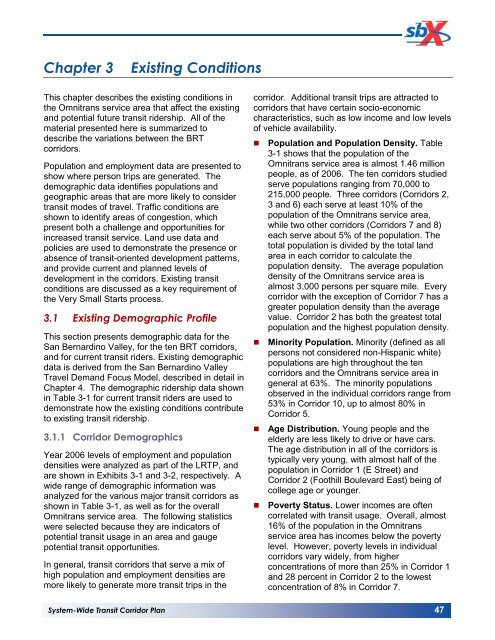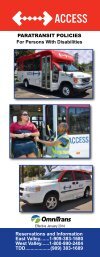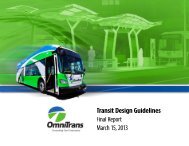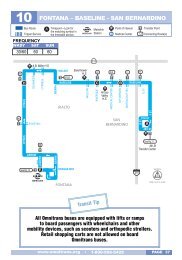New! System-Wide Transit Corridor Plan for the San ... - Omnitrans
New! System-Wide Transit Corridor Plan for the San ... - Omnitrans
New! System-Wide Transit Corridor Plan for the San ... - Omnitrans
Create successful ePaper yourself
Turn your PDF publications into a flip-book with our unique Google optimized e-Paper software.
Chapter 3<br />
Existing Conditions<br />
This chapter describes <strong>the</strong> existing conditions in<br />
<strong>the</strong> <strong>Omnitrans</strong> service area that affect <strong>the</strong> existing<br />
and potential future transit ridership. All of <strong>the</strong><br />
material presented here is summarized to<br />
describe <strong>the</strong> variations between <strong>the</strong> BRT<br />
corridors.<br />
Population and employment data are presented to<br />
show where person trips are generated. The<br />
demographic data identifies populations and<br />
geographic areas that are more likely to consider<br />
transit modes of travel. Traffic conditions are<br />
shown to identify areas of congestion, which<br />
present both a challenge and opportunities <strong>for</strong><br />
increased transit service. Land use data and<br />
policies are used to demonstrate <strong>the</strong> presence or<br />
absence of transit-oriented development patterns,<br />
and provide current and planned levels of<br />
development in <strong>the</strong> corridors. Existing transit<br />
conditions are discussed as a key requirement of<br />
<strong>the</strong> Very Small Starts process.<br />
3.1 Existing Demographic Profile<br />
This section presents demographic data <strong>for</strong> <strong>the</strong><br />
<strong>San</strong> Bernardino Valley, <strong>for</strong> <strong>the</strong> ten BRT corridors,<br />
and <strong>for</strong> current transit riders. Existing demographic<br />
data is derived from <strong>the</strong> <strong>San</strong> Bernardino Valley<br />
Travel Demand Focus Model, described in detail in<br />
Chapter 4. The demographic ridership data shown<br />
in Table 3-1 <strong>for</strong> current transit riders are used to<br />
demonstrate how <strong>the</strong> existing conditions contribute<br />
to existing transit ridership.<br />
3.1.1 <strong>Corridor</strong> Demographics<br />
Year 2006 levels of employment and population<br />
densities were analyzed as part of <strong>the</strong> LRTP, and<br />
are shown in Exhibits 3-1 and 3-2, respectively. A<br />
wide range of demographic in<strong>for</strong>mation was<br />
analyzed <strong>for</strong> <strong>the</strong> various major transit corridors as<br />
shown in Table 3-1, as well as <strong>for</strong> <strong>the</strong> overall<br />
<strong>Omnitrans</strong> service area. The following statistics<br />
were selected because <strong>the</strong>y are indicators of<br />
potential transit usage in an area and gauge<br />
potential transit opportunities.<br />
In general, transit corridors that serve a mix of<br />
high population and employment densities are<br />
more likely to generate more transit trips in <strong>the</strong><br />
corridor. Additional transit trips are attracted to<br />
corridors that have certain socio-economic<br />
characteristics, such as low income and low levels<br />
of vehicle availability.<br />
• Population and Population Density. Table<br />
3-1 shows that <strong>the</strong> population of <strong>the</strong><br />
<strong>Omnitrans</strong> service area is almost 1.46 million<br />
people, as of 2006. The ten corridors studied<br />
serve populations ranging from 70,000 to<br />
215,000 people. Three corridors (<strong>Corridor</strong>s 2,<br />
3 and 6) each serve at least 10% of <strong>the</strong><br />
population of <strong>the</strong> <strong>Omnitrans</strong> service area,<br />
while two o<strong>the</strong>r corridors (<strong>Corridor</strong>s 7 and 8)<br />
each serve about 5% of <strong>the</strong> population. The<br />
total population is divided by <strong>the</strong> total land<br />
area in each corridor to calculate <strong>the</strong><br />
population density. The average population<br />
density of <strong>the</strong> <strong>Omnitrans</strong> service area is<br />
almost 3,000 persons per square mile. Every<br />
corridor with <strong>the</strong> exception of <strong>Corridor</strong> 7 has a<br />
greater population density than <strong>the</strong> average<br />
value. <strong>Corridor</strong> 2 has both <strong>the</strong> greatest total<br />
population and <strong>the</strong> highest population density.<br />
• Minority Population. Minority (defined as all<br />
persons not considered non-Hispanic white)<br />
populations are high throughout <strong>the</strong> ten<br />
corridors and <strong>the</strong> <strong>Omnitrans</strong> service area in<br />
general at 63%. The minority populations<br />
observed in <strong>the</strong> individual corridors range from<br />
53% in <strong>Corridor</strong> 10, up to almost 80% in<br />
<strong>Corridor</strong> 5.<br />
• Age Distribution. Young people and <strong>the</strong><br />
elderly are less likely to drive or have cars.<br />
The age distribution in all of <strong>the</strong> corridors is<br />
typically very young, with almost half of <strong>the</strong><br />
population in <strong>Corridor</strong> 1 (E Street) and<br />
<strong>Corridor</strong> 2 (Foothill Boulevard East) being of<br />
college age or younger.<br />
• Poverty Status. Lower incomes are often<br />
correlated with transit usage. Overall, almost<br />
16% of <strong>the</strong> population in <strong>the</strong> <strong>Omnitrans</strong><br />
service area has incomes below <strong>the</strong> poverty<br />
level. However, poverty levels in individual<br />
corridors vary widely, from higher<br />
concentrations of more than 25% in <strong>Corridor</strong> 1<br />
and 28 percent in <strong>Corridor</strong> 2 to <strong>the</strong> lowest<br />
concentration of 8% in <strong>Corridor</strong> 7.<br />
<strong>System</strong>-<strong>Wide</strong> <strong>Transit</strong> <strong>Corridor</strong> <strong>Plan</strong> 47














